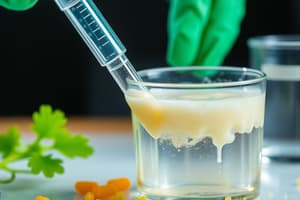Podcast
Questions and Answers
Which microorganism is NOT typically associated with food biotechnology?
Which microorganism is NOT typically associated with food biotechnology?
- Yeast
- Bacteria
- Viruses (correct)
- Molds
What is a primary benefit of using biotechnology in the food industry?
What is a primary benefit of using biotechnology in the food industry?
- Enhanced food safety (correct)
- Increased food waste
- Decreased variety of food products
- Higher costs of production
Which process is essential for the production of food using microorganisms?
Which process is essential for the production of food using microorganisms?
- Photosynthesis
- Fermentation (correct)
- Hydrolysis
- Oxidation
Which of the following is considered an enzyme application in the food industry?
Which of the following is considered an enzyme application in the food industry?
Which term describes the ethical considerations in food biotechnology?
Which term describes the ethical considerations in food biotechnology?
What does the term fermentation derive from?
What does the term fermentation derive from?
Which of the following best describes food fermentation?
Which of the following best describes food fermentation?
Which historical evidence indicates the use of fermentation in ancient times?
Which historical evidence indicates the use of fermentation in ancient times?
Who is credited with founding zymology, the study of fermentation?
Who is credited with founding zymology, the study of fermentation?
In which ancient civilization is there strong evidence of fermentation as early as 3000 BC?
In which ancient civilization is there strong evidence of fermentation as early as 3000 BC?
What is a key requirement for successful fermentation in terms of raw materials?
What is a key requirement for successful fermentation in terms of raw materials?
Which of the following best describes the role of downstream processing in fermentation?
Which of the following best describes the role of downstream processing in fermentation?
What is one of the primary benefits attributed to fermentation?
What is one of the primary benefits attributed to fermentation?
Fermentation was historically significant in the development of which scientific disciplines?
Fermentation was historically significant in the development of which scientific disciplines?
What challenge is commonly encountered during fermentation regarding the final product?
What challenge is commonly encountered during fermentation regarding the final product?
Which aspect is NOT considered a defect of fermentation-based industries?
Which aspect is NOT considered a defect of fermentation-based industries?
What is involved in the upstream processing of fermentation?
What is involved in the upstream processing of fermentation?
What are primary fermentation products primarily responsible for in an organism?
What are primary fermentation products primarily responsible for in an organism?
Which of the following is classified as a secondary product of fermentation?
Which of the following is classified as a secondary product of fermentation?
What is the role of enzymes in the context of fermentation?
What is the role of enzymes in the context of fermentation?
Why are fermentation processes generally considered inexpensive?
Why are fermentation processes generally considered inexpensive?
Which application area does NOT typically utilize fermentation products?
Which application area does NOT typically utilize fermentation products?
What distinguishes external enzymes from internal enzymes in fermentation?
What distinguishes external enzymes from internal enzymes in fermentation?
What would likely happen if secondary fermentation products were absent in an organism?
What would likely happen if secondary fermentation products were absent in an organism?
Which of the following is NOT considered a feature of fermentation-based industries?
Which of the following is NOT considered a feature of fermentation-based industries?
Which type of fermentation product is responsible for aiding in solid waste recycling?
Which type of fermentation product is responsible for aiding in solid waste recycling?
What type of enzyme would be responsible for breaking down nucleic acids during fermentation?
What type of enzyme would be responsible for breaking down nucleic acids during fermentation?
Yeasts play an unimportant role in food biotechnology.
Yeasts play an unimportant role in food biotechnology.
The process of fermentation is exclusive to bacteria and does not involve any other microorganisms.
The process of fermentation is exclusive to bacteria and does not involve any other microorganisms.
Nanotechnology can be applied in the food industry to enhance safety and quality.
Nanotechnology can be applied in the food industry to enhance safety and quality.
Genetic engineering is unrelated to food biotechnology.
Genetic engineering is unrelated to food biotechnology.
Enzymes are used in food biotechnology mainly for digestion.
Enzymes are used in food biotechnology mainly for digestion.
Fermentation technology has only been utilized in modern times.
Fermentation technology has only been utilized in modern times.
The study of fermentation is known as zymology.
The study of fermentation is known as zymology.
Fermentation only produces alcohol as a final product.
Fermentation only produces alcohol as a final product.
Evidence points to the occurrence of fermentation in ancient Babylon around 500 BC.
Evidence points to the occurrence of fermentation in ancient Babylon around 500 BC.
The term 'fermentation' comes from the Greek word for boiling.
The term 'fermentation' comes from the Greek word for boiling.
Fermentation only occurs under aerobic conditions.
Fermentation only occurs under aerobic conditions.
The submerged fermentation system is more space-efficient than solid state fermentation.
The submerged fermentation system is more space-efficient than solid state fermentation.
Fermentation can only involve yeast as the microorganism.
Fermentation can only involve yeast as the microorganism.
The modern concept of fermentation focuses solely on the production of alcohol.
The modern concept of fermentation focuses solely on the production of alcohol.
Fermentation is defined as a process that enhances the integrity of food.
Fermentation is defined as a process that enhances the integrity of food.
Study Notes
Biotechnology in Food
- Biotechnology is the application of biological organisms and processes to solve problems or produce useful products
- Food biotechnology is the use of such techniques in the food industry
- Applications of biotechnology in the food industry include:
- Microorganisms associated with food
- Fermentation
- Genetically modified foods
- Enzymes in food industry
- Nanotechnology in agriculture and food industry
- Bioethics
- Food biotechnology refers to the use of living organisms or their products to enhance food production, processing, and preservation.
Fermentation in Food Industry
- Fermentation is a metabolic process that converts sugars into alcohol, organic acids, and carbon dioxide
- Historical development:
- Evidence suggests that humans have been fermenting food for thousands of years
- Early examples include brewing of beer and wine making
- Louis Pasteur (1856) discovered the role of yeast in fermentation
Fermentation: Products and Applications
- Primary products of fermentation: Sugars, amino acids, fatty acids
- Secondary products: Antibiotics, hormones, vitamins
- Enzymes: Bio-stimulating proteins that catalyze reactions in cells
- Internal enzymes: Involved in processes like construction and degradation
- External enzymes: Often involved in hydrolysis processes
Fermentation: Features and Defects
-
Features of fermentation-based industries:
- Production of organic products
- Low-temperature processes, reducing energy requirements
- Moderate pH conditions, making operations easier
- Utilizing waste materials as raw materials
- Environmentally friendly, minimizing pollution
-
Defects of fermentation-based industries:
- Relatively low product yields
- Challenges in maintaining strain purity
- Difficulties in separating products from raw materials
Factors Influencing Microbial Activity in Fermentation
- Nutrient Availability: Adequate supply of sugars, amino acids, and other essential nutrients
- Temperature: Optimizing temperature for microbial growth and activity
- pH: Maintaining a pH suitable for the specific microorganisms
- Oxygen Availability: Aerobic fermentation requires oxygen, while anaerobic fermentation does not
- Presence of Inhibitors: Avoiding inhibitors that may hinder microbial growth
Fermentation: The Process
- Upstream processing:
- Preparation of the microorganism inoculum
- Sterilization of the fermentation medium
- Fermentation:
- Growth of the microorganism in a bioreactor
- Production of the desired product
- Downstream processing:
- Separation of the product from the fermentation broth
- Purification and concentration of the product
Types of Fermentation Processes:
- Batch culture:
- Closed system where everything is added at the start
- Nutrients, oxygen, and pH are not replenished during fermentation
- Fed-batch culture:
- Nutrients are added in small doses during fermentation
- Useful for reducing catabolite repression
- Continuous culture:
- Nutrients are continuously added and products are continuously removed
- Maintains microorganisms in their logarithmic growth stage
- Suitable for primary metabolite production
Fermentation: Applications
- Medical: Antibiotic production, vitamins
- Chemicals: Organic acids, solvents
- Agriculture: Green manure, fodder
- Fuel: Biofuel
- Food: Dairy products, beverages
- Environment: Solid waste recycling, sewage treatment
Introduction To Food Biotechnology
- Food biotechnology is the use of living organisms to produce food, improve food production, and develop new food products.
- Branches of biotechnology include microbial biotechnology, genetic engineering, and enzyme technology.
- Benefits of biotechnology include improving food safety, increasing food production, and developing new food products.
- Food biotechnology safety and regulations are important to ensure the safety and quality of food products.
Importance of Microorganisms in Food Biotechnology
- Microorganisms are essential for many food production processes, particularly fermentation.
- Microorganisms like bacteria, yeasts, and molds are involved in various food production processes, including bread, cheese, yogurt, and beer.
Fermentation
- Fermentation is a natural process that involves the breakdown of organic substances by microorganisms.
- In the context of food production, fermentation is used to make many food products, such as bread, cheese, yogurt, sauerkraut, kimchi, and alcoholic beverages.
- Fermentation is typically carried out in fermenters, also known as bioreactors.
- There are three main types of fermentation processes: batch, fed-batch, and continuous.
- Fermentation is a key process in food production, as it results in several important changes to food products:
- Production of acids that preserve food and impart unique flavors.
- Production of alcohol that is used to make alcoholic beverages.
- Production of gases that are responsible for the texture of bread and other fermented foods.
Fermentation Processes
- Batch culture: A closed system where the fermentor is inoculated with the microorganisms and the process is allowed to proceed to completion.
- Fed-batch culture: An enhanced version of batch culture, with nutrients added to the fermentor during the process; it allows for control over nutrient feeding, thus preventing catabolite repression.
- Continuous culture: A continuous process where nutrients are constantly added to the fermentor, while the product is constantly removed.
Features of Fermentation-Based Industries
- Fermentation-based industries produce a wide range of food products, from dairy products to alcoholic beverages to meat products.
- These industries are generally low-temperature and do not require high energy inputs, making them relatively inexpensive to operate.
- Fermentation products are often organic and difficult to synthesize using other methods, making fermentation a valuable technique for food production.
Applications of Food Biotechnology
- Food biotechnology has numerous applications across the food system, including the medical, chemical, agricultural, and environmental sectors.
- Applications of food biotechnology span the production of: proteins, vitamins, antibiotics, organic acids, toxins, inorganic chemicals, organic chemicals, green manure, fodder, biofuels, dairy products, beverages, solid waste recycling, and environmental treatments.
Nanotechnology in Food
- Nanotechnology is a rapidly developing field that involves manipulating materials at the atomic and molecular level.
- Nanotechnology has applications in food production, including the development of new food packaging materials, food preservation techniques, and food-quality sensing methods.
- Nanotechnology in food production has raised ethical concerns, including potential impacts on human health and the environment.
Studying That Suits You
Use AI to generate personalized quizzes and flashcards to suit your learning preferences.
Related Documents
Description
Explore the fascinating applications of biotechnology in the food industry, including the role of microorganisms, fermentation processes, and genetically modified foods. Delve into historical developments and the impact of fermentation on food preservation and production. This quiz will enhance your understanding of food biotechnology and its significance.




